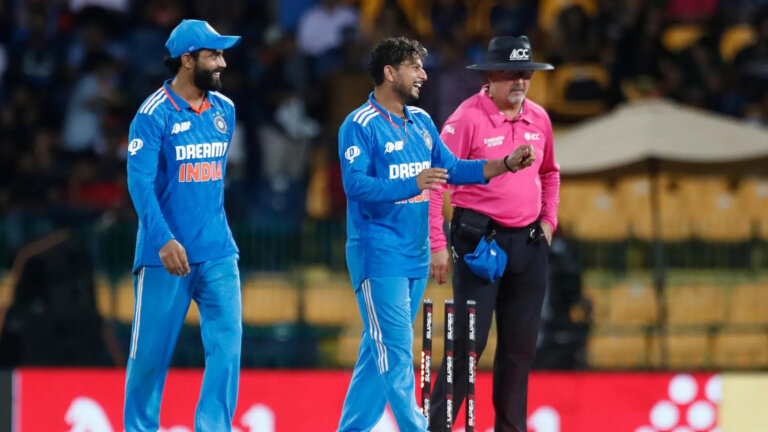
On Tuesday night in Gqeberha, the haves played the have-nots and won. There was a whiff of respectability about the scoreline, but that was largely because the have-nots had a batter and a bowler who each suggested they might one day cross over to the haves. The truth of it is that they probably won’t.
Written in black and white, Australia beat Bangladesh by eight wickets. So far, so expected. And unfortunately for the women’s game, the likelihood of such expectations being torpedoed in future encounters appears to be shrinking in the wake of events this week.
The inaugural WPL auction has widely been praised as a gamechanger for women’s cricket, and that is undoubtedly true. Yet there are also valid concerns that it will entrench the status quo, rewarding players from nations that invested in the women’s game early and ultimately coronating India in years to come, whilst leaving everyone else behind.
In the Federation for International Cricketers’ Association’s global employment report for women’s cricket, which was released on the eve of the T20 World Cup, chief executive Tom Moffat forecast that the WPL will create a new “top of the pyramid” for players. The results of the auction bear testament to that prediction.
Of the players who took the field for Australia on Tuesday, only one had not earned a WPL contract. The best team in the world had two more WPL players amongst their reserves in the dugout and two back home. Bangladesh had none.
Such inequality showed up in a myriad of ways at St George’s Park.
When Meg Lanning danced down the pitch to hit Nahida Akter past mid-on with a nonchalant short-arm jab for four, the look on the bowler’s face was quizzical, disbelief at how Lanning had executed such a shot hanging in the air between them. There had been many times in Bangladesh’s innings when batters struggled to hit the ball off the square, their tentative forward defences full of uncertainty and frustration. By contrast, Lanning’s easy forward press to a sharp inswinging delivery from Marufa Akter, the liveliest Bangladeshi bowler on display, pierced the gap in the infield and earned two runs.
Bangladesh have not won a game in the T20 World Cup since they hosted it in 2014, with defeat on Tuesday making it 14 losses on the trot. Australia have lost just four games in the competition during the same period, lifting the trophy in 2014, 2018 and 2020.
FICA’s report said that there is “a clear correlation between on-field performance, and off field structures and investment.” Promisingly, it highlighted advances made in most major cricketing nations, with Bangladesh among them. Last year the BCB offered 24 central contracts to women, more than any other nation. Ireland were next with 22, followed by Pakistan and Sri Lanka with 20. However, the report added that remuneration and employment terms for Bangladeshi players “remained below that of several other nations”.
This figure also requires context. Australia may only have 15 centrally-contracted women, but their domestic structure is vast: a total of 123 players hold contracts, most of which provide sufficient financial security to apply themselves to cricket full time. As an early investor in women’s cricket, they have led the pack for more than a decade.
A string of lucrative WPL deals for their top stars looks like just reward for their pursuit of gender equality. It also offers an opportunity to pull away from the chasing pack, just when it appeared as though the gap could be closing. Last year, Bangladesh ran them close in the 50-over World Cup, and also troubled the West Indies and beat Pakistan. Those showings suggested a second coming for Bangladesh, their first having been at the 2018 Asia Cup, which they won after beating India twice. If there’s an advantage of coming from a low base of professionalism, it’s that there is plenty of ground that can be made up quickly – at a time when teams like Australia appear to be entering ‘marginal gains’ territory.
Yet the advent of the WPL suggests that the ceiling in women’s cricket just got higher. That is affecting teams not only like Bangladesh, but also New Zealand. For a long time, the White Ferns have been torch-bearers for the women’s game, riding on a progressive sporting culture that valued gender equality. Despite many hiccups at global events, their form in bilateral cricket has always been strong, in large part due to a robust domestic structure. Yet in the wake of back-to-back defeats over the past week, a distraught Sophie Devine reflected that this structure might not look so flash any more.
“If I’m being brutally honest, I’m not sure if (our domestic game) is preparing us for international cricket, and you’re seeing now obviously the WBBL, the Hundred and now the WPL, they’re highly competitive tournaments and they’re preparing players,” she said. “We’ve seen Australia, we’re seeing England and I’m scared to think what India’s going to be like with the opportunities that they give themselves. I think we’ve done great things in New Zealand with our domestic cricket but I’m not sure it’s at the same standard as those other competitions.”
Of paramount concern to such countries must be the limited number of places available in the WPL, which has started with five teams – three fewer than the IPL had when it launched 15 years ago. In comparison to the 14 WPL contracts picked up by Australians and seven by English players, there were only nine more among the other nations. South Africa earned four, New Zealand and West Indies two each, and American player Tara Norris was the only Associate bought, despite the BCCI’s lure of franchises being able to field an Associate at the expense of a local player.
While the expansion of leagues is to be celebrated, it will also reduce the windows available for bilateral cricket, with women’s fixtures already loaded in favour of the haves. Bangladesh are yet to face Australia outside of an ICC event, and while the new 50-over Women’s Championship will guarantee them 24 matches against eight teams in the next cycle, a burgeoning schedule makes it unlikely that India, Australia and England will be setting up too many fixtures against the weaker sides. FICA has called for clear windows to be created in the women’s game to ensure some sort of structure, but similar pleas in the men’s game were ignored by the ICC until it was too late.
This leaves the franchise leagues, which may be buffered by a Pakistani addition in September, as the best hope for standout talent from nations outside the Big Three. “There will be more opportunities ahead since this WPL has just started for the first time and it’ll not be stopped, I hope,” Bangladesh captain Nigar Sultana said optimistically after Tuesday’s game. “So, next year, God willing, we will see that 2-3 players from Bangladesh can be selected. So far, none of us is actually thinking about it. We just hope that we can perform well as a team for our country so that the whole world can see how we are improving day by day.”
Nigar’s half-century against the Australians on Tuesday highlighted her as one to watch, though as a fast bowler, 18-year-old Marufa looks the likeliest Bangladeshi to cross the divide from the have-nots. But not before the haves get stronger, richer and better.




